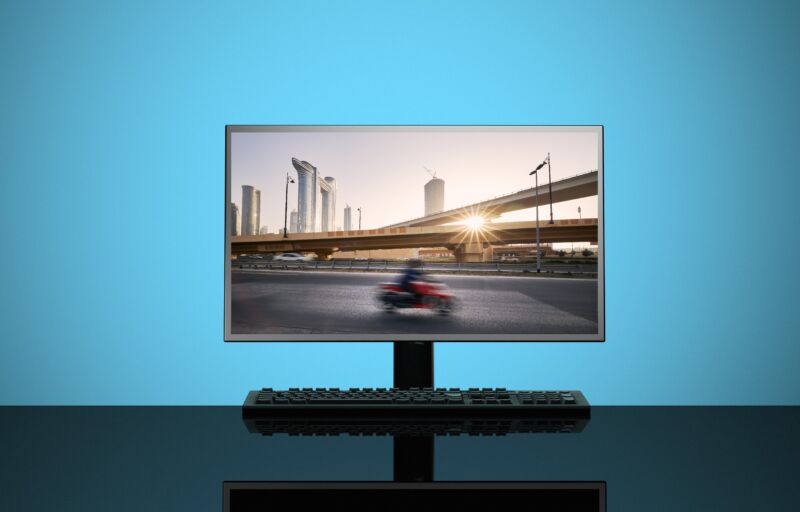
Enlarge (credit: Scharon Harding/Getty Images)
Let's say you're buying a new PC monitor, TV, or laptop and want an idea of how clear fast movement would appear on it. What information would you consider? Specs like response time and refresh rate provide an idea of display speed. But if you think about it, a measurement of time isn't a particularly straightforward answer to the question of, "How much motion blur will I see?" In response, the Video Electronics Standards Association (VESA), which makes other display standards, including DisplayPort and Adaptive-Sync, today announced a new specification program that puts a label on displays quantifying their expected motion blur performance.
The Clear Motion Ratio Compliance Test Specification (ClearMR) is a standard and logo program for consumer displays, including PC monitors, TVs, laptops, tablets, and all-in-ones (several products are already certified). It introduces a series of tiers with a numerical value that's supposed to indicate to consumers the display's ratio of clear pixels to blurry ones during fast-paced movement. For example, ClearMR 7000, which has a "Clear Motion Ratio" range of 6,500 to 7,500, means the display would have a clear-to-blurry ratio of 65–75:1 or 65–75 times more clear pixels than blurry ones.
| VESA ClearMR Tier | Clear Motion Ratio (CMR) Range |
|---|---|
| ClearMR 3000 | 2,500 ≤ CMR < 3,500 |
| ClearMR 4000 | 3,500 ≤ CMR < 4,500 |
| ClearMR 5000 | 4,500 ≤ CMR < 5,500 |
| ClearMR 6000 | 5,500 ≤ CMR < 6,500 |
| ClearMR 7000 | 6,500 ≤ CMR < 7,500 |
| ClearMR 8000 | 7,500 ≤ CMR < 8,500 |
| ClearMR 9000 | 8,500 ≤ CMR |
In an interview with Ars Technica, Dale Stolitzka, senior principal researcher at Samsung Display’s America R&D Lab and lead contributor to ClearMR, said that VESA settled on ClearMR 3000 as the lowest tier befitting laptops with screens in the 90–120 Hz range. Displays that are 60 Hz would typically not qualify for ClearMR certification.
Read 14 remaining paragraphs | Comments

Enlarge (credit: Scharon Harding/Getty Images)
Let's say you're buying a new PC monitor, TV, or laptop and want an idea of how clear fast movement would appear on it. What information would you consider? Specs like response time and refresh rate provide an idea of display speed. But if you think about it, a measurement of time isn't a particularly straightforward answer to the question of, "How much motion blur will I see?" In response, the Video Electronics Standards Association (VESA), which makes other display standards, including DisplayPort and Adaptive-Sync, today announced a new specification program that puts a label on displays quantifying their expected motion blur performance.
The Clear Motion Ratio Compliance Test Specification (ClearMR) is a standard and logo program for consumer displays, including PC monitors, TVs, laptops, tablets, and all-in-ones (several products are already certified). It introduces a series of tiers with a numerical value that's supposed to indicate to consumers the display's ratio of clear pixels to blurry ones during fast-paced movement. For example, ClearMR 7000, which has a "Clear Motion Ratio" range of 6,500 to 7,500, means the display would have a clear-to-blurry ratio of 65–75:1 or 65–75 times more clear pixels than blurry ones.
| VESA ClearMR Tier | Clear Motion Ratio (CMR) Range |
|---|---|
| ClearMR 3000 | 2,500 ≤ CMR < 3,500 |
| ClearMR 4000 | 3,500 ≤ CMR < 4,500 |
| ClearMR 5000 | 4,500 ≤ CMR < 5,500 |
| ClearMR 6000 | 5,500 ≤ CMR < 6,500 |
| ClearMR 7000 | 6,500 ≤ CMR < 7,500 |
| ClearMR 8000 | 7,500 ≤ CMR < 8,500 |
| ClearMR 9000 | 8,500 ≤ CMR |
In an interview with Ars Technica, Dale Stolitzka, senior principal researcher at Samsung Display’s America R&D Lab and lead contributor to ClearMR, said that VESA settled on ClearMR 3000 as the lowest tier befitting laptops with screens in the 90–120 Hz range. Displays that are 60 Hz would typically not qualify for ClearMR certification.
Read 14 remaining paragraphs | Comments
August 22, 2022 at 09:30PM

Post a Comment